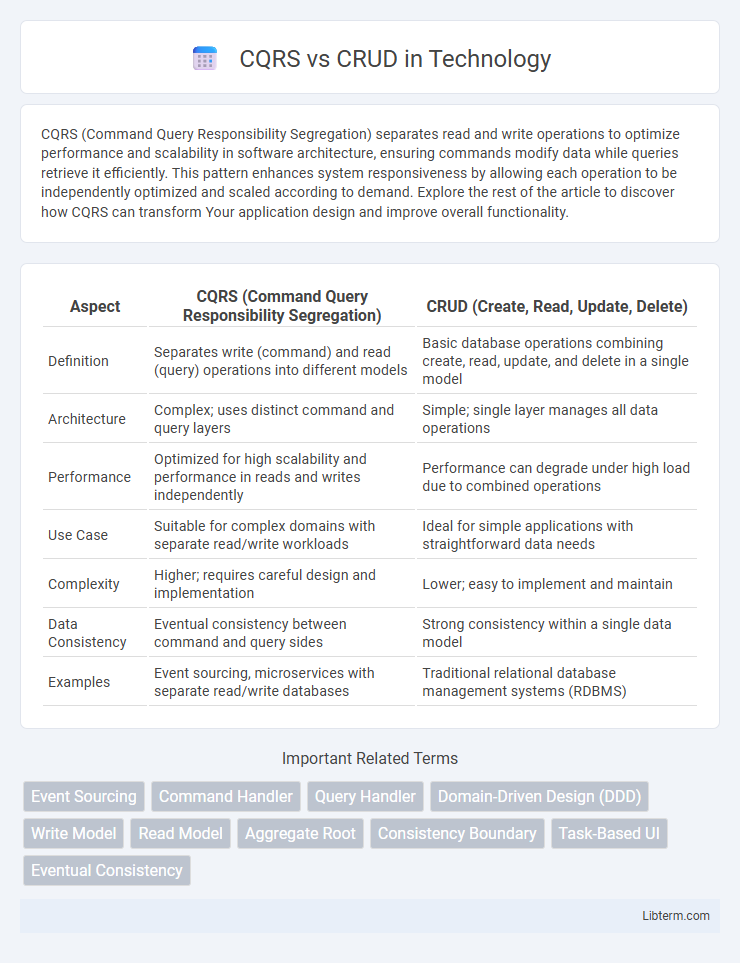CQRS (Command Query Responsibility Segregation) separates read and write operations to optimize performance and scalability in software architecture, ensuring commands modify data while queries retrieve it efficiently. This pattern enhances system responsiveness by allowing each operation to be independently optimized and scaled according to demand. Explore the rest of the article to discover how CQRS can transform Your application design and improve overall functionality.
Table of Comparison
| Aspect | CQRS (Command Query Responsibility Segregation) | CRUD (Create, Read, Update, Delete) |
|---|---|---|
| Definition | Separates write (command) and read (query) operations into different models | Basic database operations combining create, read, update, and delete in a single model |
| Architecture | Complex; uses distinct command and query layers | Simple; single layer manages all data operations |
| Performance | Optimized for high scalability and performance in reads and writes independently | Performance can degrade under high load due to combined operations |
| Use Case | Suitable for complex domains with separate read/write workloads | Ideal for simple applications with straightforward data needs |
| Complexity | Higher; requires careful design and implementation | Lower; easy to implement and maintain |
| Data Consistency | Eventual consistency between command and query sides | Strong consistency within a single data model |
| Examples | Event sourcing, microservices with separate read/write databases | Traditional relational database management systems (RDBMS) |
Understanding CRUD: The Traditional Data Management Approach
CRUD (Create, Read, Update, Delete) represents the foundational operations for managing data in traditional database systems, emphasizing straightforward transaction models for modifying and retrieving data. This pattern tightly couples data modification and retrieval within a single model, often leading to challenges in scalability and performance as application complexity grows. Despite its simplicity and widespread adoption, CRUD can limit responsiveness and optimization opportunities in highly concurrent or distributed systems, where command and query separation offers distinct advantages.
What is CQRS? A Brief Overview
CQRS (Command Query Responsibility Segregation) is a design pattern that separates read and write operations into distinct models, optimizing performance, scalability, and security. Unlike traditional CRUD (Create, Read, Update, Delete) approaches that handle data modification and retrieval in a unified model, CQRS splits these responsibilities to allow independent scaling and specialized handling. This separation enables event-driven architectures and improves consistency in complex, high-demand applications.
Key Differences Between CQRS and CRUD
CQRS (Command Query Responsibility Segregation) separates the read and write operations into distinct models, while CRUD (Create, Read, Update, Delete) combines these operations into a single model. CQRS optimizes scalability and performance by allowing independent scaling of command and query paths, whereas CRUD offers simplicity and ease of implementation for basic data manipulation. CQRS is ideal for complex domains requiring high responsiveness and consistency, whereas CRUD suits straightforward applications with minimal concurrency concerns.
Advantages of Using CRUD in Application Development
CRUD architecture simplifies application development by offering a straightforward, easy-to-understand model for data management through its four core operations: Create, Read, Update, and Delete. It provides seamless integration with relational databases and supports rapid development cycles due to its convention-based approach. CRUD's simplicity reduces development costs and accelerates feature implementation, making it ideal for applications with uncomplicated data manipulation requirements.
Benefits of Adopting CQRS Architecture
CQRS architecture separates command and query responsibilities, improving system scalability and performance by optimizing read and write operations independently. It enhances maintainability through clear boundaries, allowing teams to develop, deploy, and scale components without affecting each other. CQRS also facilitates complex domain modeling and supports event sourcing, providing better audit trails and enabling more robust data consistency strategies compared to traditional CRUD models.
Common Use Cases for CRUD Operations
CRUD operations are commonly used in applications requiring simple data manipulation, such as content management systems, user profiles, and inventory management where direct interaction with a single database simplifies development. Typical CRUD use cases involve scenarios demanding straightforward Create, Read, Update, and Delete functionality without complex business logic or scalability requirements. This approach excels in small to medium-sized projects where maintaining consistency and ease of implementation is a priority over specialized command and query separation.
When to Implement CQRS Over CRUD
Implement CQRS over CRUD when your application requires distinct read and write operations to optimize performance, scalability, and maintainability. CQRS is highly effective in complex domains with frequent updates and heavy querying, enabling separation of concerns and tailored data models for commands and queries. Choose CQRS when eventual consistency is acceptable, and the overhead of managing separate models outweighs the simplicity of CRUD.
Performance and Scalability: CQRS vs CRUD
CQRS (Command Query Responsibility Segregation) enhances performance and scalability by separating read and write operations, allowing each to be optimized independently and scaled according to their specific workloads. CRUD (Create, Read, Update, Delete) architectures often face scalability bottlenecks when handling complex transactional workloads due to tightly coupled read and write operations. CQRS supports distributed systems better by enabling asynchronous processing and eventual consistency, which significantly improves throughput and responsiveness compared to traditional CRUD models.
Challenges and Drawbacks of Each Approach
CQRS introduces complexity with its separation of read and write models, leading to eventual consistency challenges and increased development overhead. CRUD simplifies development with a unified model but struggles with scalability and performance bottlenecks under high load. Both approaches require careful consideration of system requirements to balance maintainability, consistency, and efficiency.
How to Choose Between CQRS and CRUD for Your Project
Choosing between CQRS and CRUD depends on the complexity and scalability requirements of your project; use CRUD for simple applications with straightforward data manipulation needs, ensuring ease of implementation and maintenance. Opt for CQRS when your project demands high scalability, complex business logic, or distinct read and write workload patterns, allowing optimization of each side independently for performance and security. Evaluating factors such as domain complexity, expected load, and development resources helps determine whether the separation of concerns in CQRS outweighs the simplicity of CRUD.
CQRS Infographic

 libterm.com
libterm.com